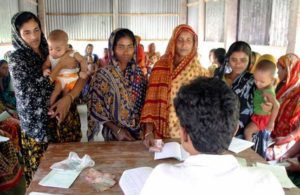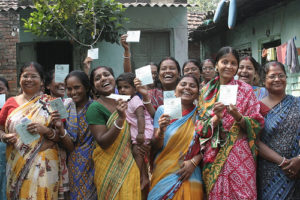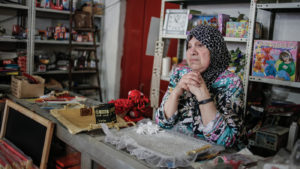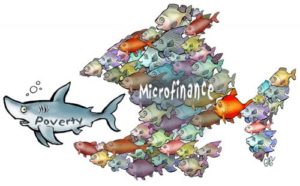Microfinance was born in the early 1980s when an economist named Muhammad Yunus came across women in poverty from the villages of Bangladesh. In face of the widespread famine and poverty, some of these women and their families were controlled by loan sharks, and had no other resource to turn to because traditional banks considered them not creditworthy. Muhammad Yunus repaid the women’s debt and helped them get loans from the bank as a guarantor. Soon, working with the poor made him realize that lending money to the disadvantaged is a great business opportunity: they were trustworthy, hardworking people. He then created Grameen Bank, what we consider a pioneering model of social enterprise, to help break the cycle of poverty.
Muhammad Yunus has received a Nobel Peace Prize in 2006 and a US Congressional Gold Medal in 2010, among many other prizes, as recognition of his contributions to the fight against global poverty. Despite the approbation Yunus has received, the concept of microfinance has been the subject of many debates and controversies. Some critics question whether microfinance is truly an effective way to lift the poor out of poverty. Others make the claim that instead of helping the poor, microfinance institutions (MFIs) make their clients poorer, as they become victims of a vicious spiral of over-indebtedness. It is important for us to understand this debate to keep us attentive to ensuring that we remain on the right track as we’re trying to fight global poverty. However, in order to understand the debate and the truth about microfinance, we need to first understand how the model works.
For over three decades, the Grameen Bank has succeeded in reaching the poor, while traditional banks ignore this population. Grameen bank established branches and sent representatives into remote areas of developing countries, and took on many clients there. The reason why Grameen was able to do that is that borrowers do not need collateral to get a loan. This policy allows access for the disadvantaged to get loans more easily to support their small businesses and livelihood. These loans are typically made in very small amounts, averaging at $200 with an interest rate below 20%, hence the “micro” in microfinance. Grameen Bank is also different from traditional banks in that it has a financially self-reliant model. In an article published in The Round Table, Yunus explained his bank’s business model: “Grameen has funded 90 percent of its loans with interest income and deposits collected, aligning the interests of its new borrowers and depositor-shareholders since 1995.” Essentially, the bank encourages all borrowers to become savers, so that their local capital can be converted into new loans to others.
In addition to the no-collateral borrowing system, another fascinating fact about Grameen Bank’s operation is that 97% of the borrowers are women. It is a brilliant business strategy because women statistically have a much higher loan repayment rate than male, for that women tend to make more conservative investments. Yunus have recognized this, and made women his target client. In an interview with The Guardian, Yunus said that he expanded the program into the US and established 19 branches in 11 cities, including eight in New York. “We have nearly 100,000 borrowers there now and 100% women. Not a single man.”
Yunus’s decision to give microloans to women isn’t just good for business, it accomplishes so much more. In rural Bangladesh, many women are essentially confined to their husband’s family compound, and are in a rather powerless position both socially and economically. Girls are usually married by 16, sometimes as young as 11. Most of the time, there are no medical professionals in attendance when women give birth. Women are expected to keep their eyes down and their voice soft, even at home. It is not considered proper for women to go to the market, or to be seen by men outside their family. Microfinance serves and empowers these women, who are often overlooked in society by giving them access to a small amount of capital so that they can buy seeds, chickens or a cow and start and grow their small businesses. Often, this allows them to earn enough to provide three meals a day instead of two for their family and their children, of whom 40% are malnourished. It also gave them a bit of cash to pay for medicines if a family member got sick.
The main criticism microfinance face is that borrowers may face abusive interest rates and end up become overwhelmed by their debt. While some institutions like BRAC have models similar to Grameen and provide services with the goal to combat poverty, other banks that label themselves as MFIs use predatory lending and collection practices. These companies charge up to 200% for interest, and some of them employ collection methods so harsh that they had driven some borrowers to commit suicide. According to an article from The Atlantic, critics often use SKS Microfinance as an example to argue that microfinance is a plot to steal from the poor and give to the rich. The company held a public IPO in 2010 that made millions for its founder, ex-McKinsey-consultant Vikram Akula. Another example is Banco Compartamos, a Mexican bank that Compartamos charges an annual percentage rate in the range of 75-100%, and raised nearly half a billion dollars in its IPO.
However, these banks do not fit the microfinance model Yunus proposed. In fact, Yunus himself is outraged by this kind of microfinance companies that make huge profits off of the backs of the very poor. He blasted Compartamos, saying, “microfinance was created to fight the money lender, not to become the money lender.” The majority are still small or very small entities that are working hard to achieve financial self-sustainability. A BYU study found that among the 148 MFIs they interviewed, only 57 are self-sufficient, and fewer report profits. The majority of the MFIs around the world are not influenced by the predatory model mentioned above, and are operating as non-profits. For-profit MFIs that uses abusive interest rates are only a small fraction of the microfinance market, and should be a reason to motivate more effort put into regulation, instead of being used to denounce microfinance as a whole.
Moreover, Aneel Karnani, a professor of strategy in University of Michigan comma published an article in Stanford Social Innovation Review, in which he argues that microfinance is not an efficient way to alleviate poverty. He claims that instead of microfinance, best way to eradicate poverty is to create jobs and to increase worker productivity. Karnani points out that most microfinance clients are not “micro-entrepreneurs” by choice, and that these borrowers would “gladly take a factory job at reasonable wages if it were available.” Therefore, he believes by people are strying away from the real effective way to fix the economy. It is true that on a macroeconomic scale, most people agree that employment is the fundamental link to poverty reduction.
However, the problem that MFI clients face in these rural areas of Bangladesh is precisely the limited opportunities for steady employment at reasonable wages. Within the status quo, microfinance is still the best opportunity for people who seek temporary financial relive and are hoping to kick start their small business. The story of Manjira who, years before, was living in extreme poverty in Bangladesh, illustrates the impact a Grameen loan can have. She had lost a young son to a sudden illness. She told the reporter at New York Times that her most painful memory was the day before her son died. He asked her for an ice cream that cost one taka (about 2 cents), but she didn’t have the money to give him that. A few years later, she managed to get a small loan through Grameen, and had become a successful seamstress. Now, she is one of the board members of Grameen Bank, along with three government representatives and eight other village women elected by the bank’s more than 8 million members.
Over the years, many other women like Manjira have found means to provide for themselves and their family with the help of microloans. As women build up their business, overall consumption increases and its benefits also extend outward to the entire community, including those who are participating in the program. However, it is important to keep in mind that microfinance does not automatically empower women. Governments and international organizations in developing nations should tighten regulation over microfinance institutions and be sensitive to the country-specific and cultural factors that play a key role in determining how microfinance interacts with the local community.




Leave a Reply
You must be logged in to post a comment.